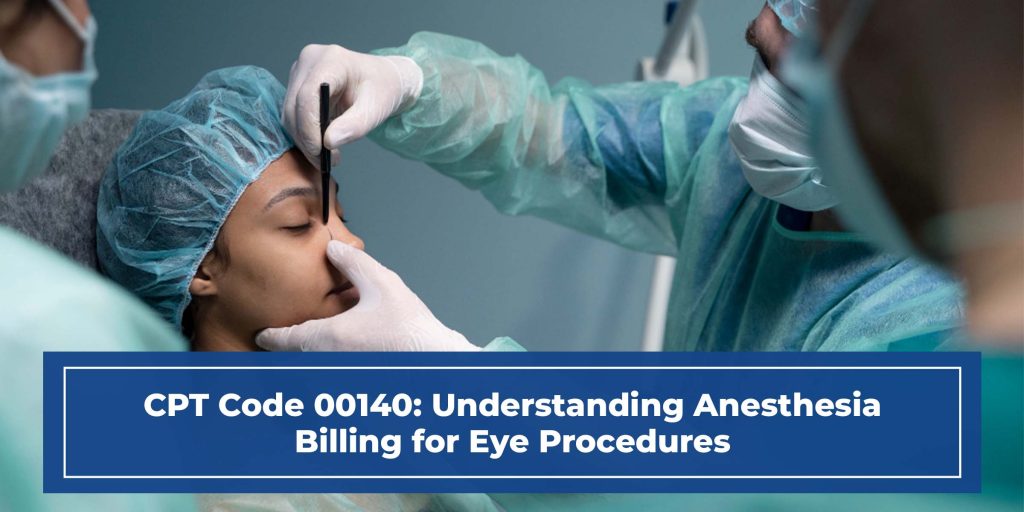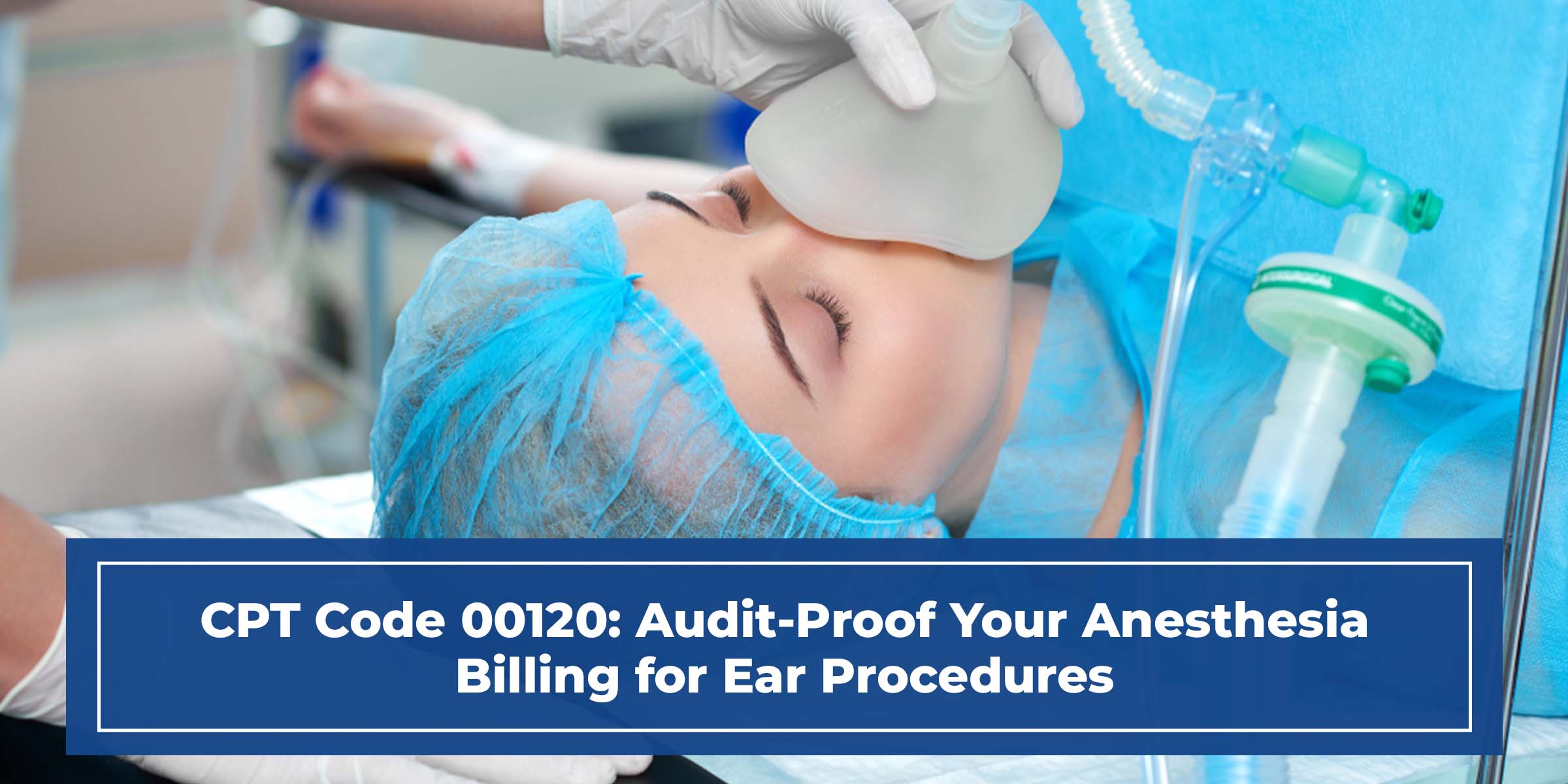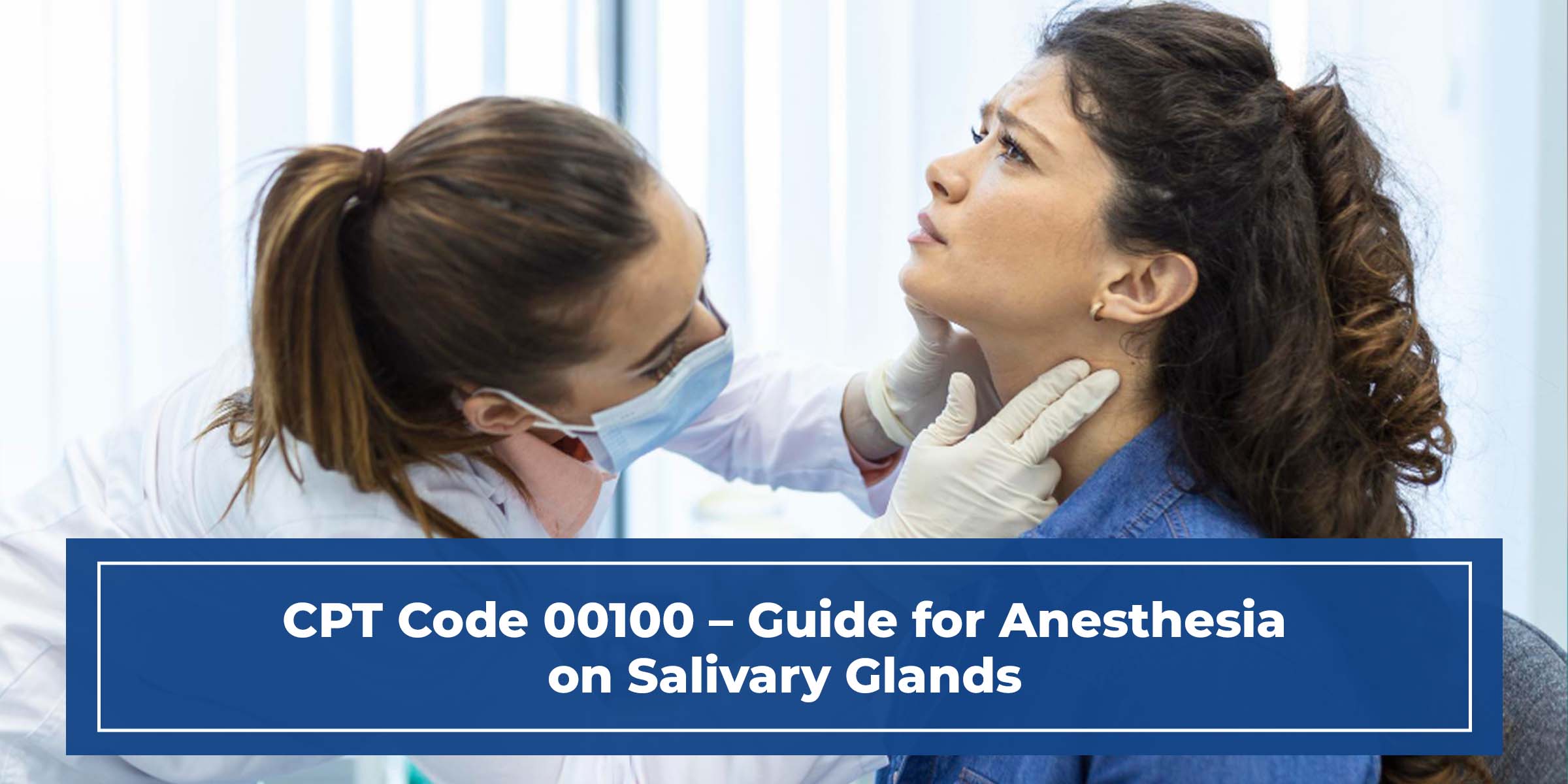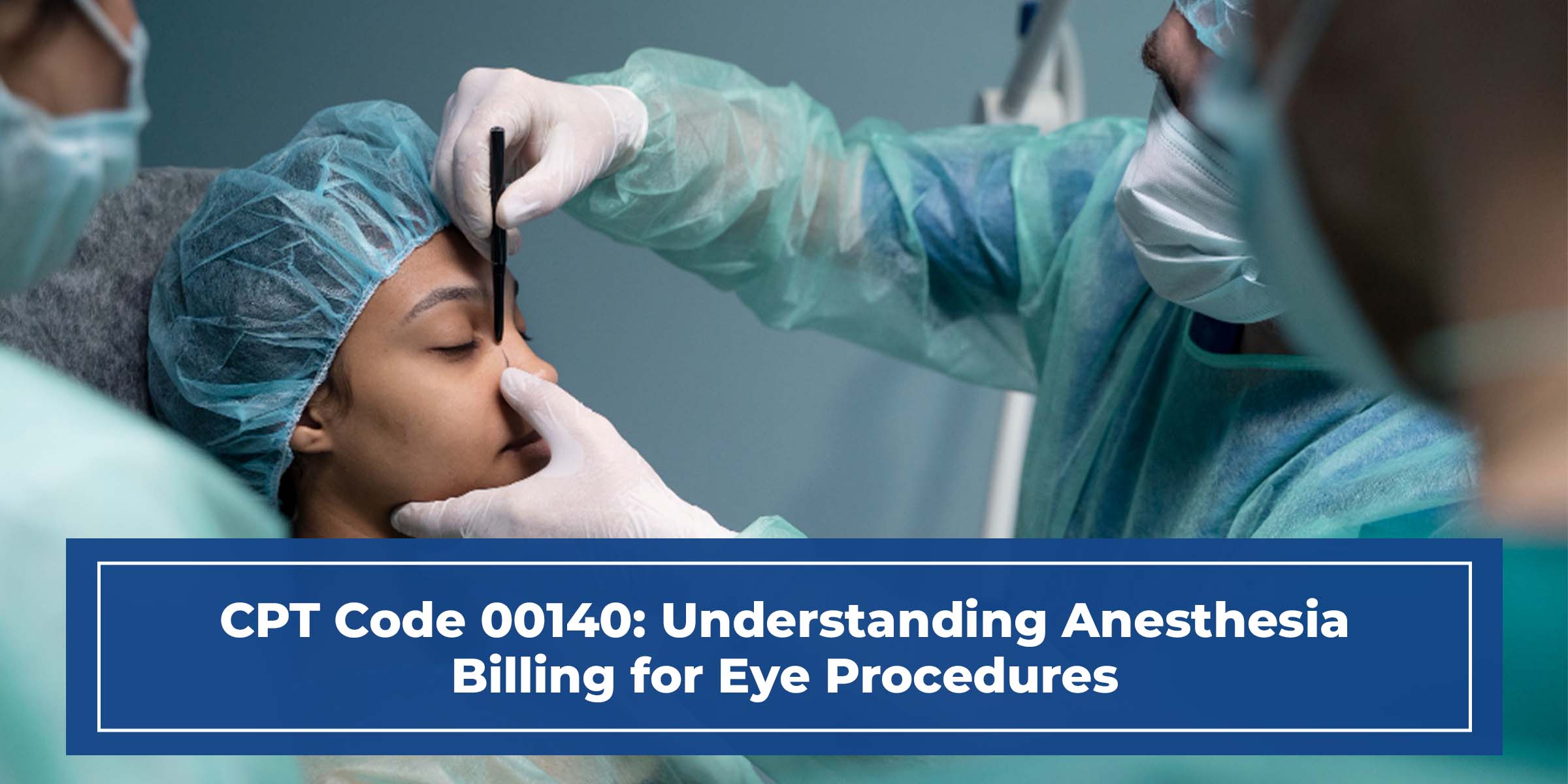What Procedures Does CPT 00140 Apply To?
CPT code 00140 is assigned for anesthesia services provided during surgical procedures on the eye. It excludes procedures involving the lens, such as cataract surgeries. Instead, it typically applies to operations on the retina, eyelid, ocular muscles, or other structures of the eye that do not involve the lens itself.
It is important for billers to confirm that the operative note aligns with this definition. Incorrect code assignment due to assumption or template use can result in rejections or payer audits.
How Are Units Calculated for CPT 00140?
Each anesthesia claim requires an accurate unit calculation. This is based on a simple formula:
(Base Units + Time Units + Modifying Units) × Conversion Factor
- Base Units: CPT 00140 carries a base value of 5 units.
- Time Units: Calculated based on anesthesia time in 15-minute increments. For example, 30 minutes equals 2 units.
- Modifying Units: These come from physical status modifiers. P1 and P2 do not add units. P3 adds 1 unit. P4 adds 2. P5 adds 3.
- Conversion Factor: Determined by the payer and contract. Medicare and commercial payers may use different values.
For 2025, Medicare set the national anesthesia conversion factor at $20.3178 per unit, slightly lower than the 2024 value of $20.7739. Commercial payers often establish their own rates, which may differ.
The final payment depends not only on this formula, but also on correct modifier use and consistent documentation.
Which Modifiers Should Be Used With This Code?
Correct modifier selection is necessary for both compliance and accuracy:
- AA: Anesthesiologist personally performed the service.
- QZ: CRNA performed the service without medical direction.
- QS: Monitored anesthesia care (used in conjunction with AA or QZ).
- P1–P5: Physical status modifiers that describe patient condition.
Modifiers should always match what is reflected in the record. A mismatch between a P4 modifier and a normal pre-op report may lead to claim rejection.
What Type of Documentation Is Needed for CPT 00140?
Documentation should include:
- Start and end times of anesthesia service.
- Surgical procedure performed (confirming it fits the definition under 00140).
- If ASA physical status modifiers are applied, ensure the anesthesia record includes the patient’s classification to justify their use
- Notes on any complicating factors, including the reason for any emergency modifier like 99140.
All documentation must align with the billed codes and modifiers. Incomplete records can delay payments or trigger payer review.
What Payer Differences Should Billers Be Aware Of?
Different payers may have different expectations:
- Medicare typically requires time-based billing and thorough documentation.
- Commercial payers might request operative reports or anesthesia logs if a modifier appears unclear.
- Medicaid programs vary by state. Some accept paper documentation. Others require full EHR submission.
Knowing each payer’s format and documentation preference is key to a clean submission.
How Does CPT 00140 Compare to Other Eye Anesthesia Codes?
Within anesthesia coding, CPT 00140 sits in a small group of codes for eye procedures. Each is used for different types of cases. Misuse between them is one of the most common reasons for claim rejections in this area.
CPT 00140 — Anesthesia for Eye Procedures (Excluding Lens)
- Covers: retina, ocular muscle surgery, biopsies, glaucoma procedures.
- Base Units: 5
- Key Detail: Not to be used for cataracts or lens operations.
CPT 00142 — Anesthesia for Lens Surgery
- Covers: cataract extraction and intraocular lens implantation.
- Base Units: 6
- Key Detail: If the lens is involved, this is the correct code, not 00140.
CPT 00144 — Anesthesia for Corneal Transplant
- Covers: keratoplasty and corneal graft procedures.
- Base Units: 7
- Key Detail: Limited to corneal work; often confused with general eye anesthesia.
CPT 00145 — Anesthesia for Vitrectomy
- Covers: posterior segment work such as vitreous body removal.
- Base Units: 6
- Key Detail: Must be specifically documented in the operative note to justify.
CPT 00147 — Anesthesia for Enucleation
- Covers: removal of the eye.
- Base Units: 9
- Key Detail: Higher risk, higher base units; requires matching documentation.
Why Is This Categorization Important?
Placing 00140 side by side with related codes clarifies its boundaries. Many billing errors happen when coders default to 00140 for “eye surgery” without noting the specific structure treated. By recognizing the differences and base unit variations, billers can apply the right code confidently and avoid unnecessary denials.
When Is It Appropriate to Use Qualifying Circumstance Codes?
Qualifying circumstance code 99140 may be added to CPT 00140 when the anesthesia service is provided under emergency conditions.
However, this should only be used when:
- The medical record clearly shows the presence of an emergency.
- The urgency of the surgery is described.
- The anesthesia team had limited preparation time.
This code can increase reimbursement, but payers often deny it when records lack evidence. Billers should confirm the urgency is documented before attaching 99140.
What Does a Proper Claim Layout for CPT 00140 Look Like?
A clear claim layout prevents errors and delays. Each service should be on its own line with accurate codes and proper modifiers.
- Line 1: 00140 with appropriate modifier(s) (e.g. AA P2)
- Line 2: 99140, only if an emergency is properly documented
- Line 3: Supply charges if applicable, coded separately
Claims should separate surgical codes, anesthesia codes, and supply lines. Avoid bundling or collapsing services into a single charge.
How Can Errors With CPT 00140 Be Prevented?
Common issues include:
- Using 00140 for procedures involving the lens.
- Assigning physical status modifiers that are unsupported by documentation.
- Inaccurate start and stop times.
- Applying monitored anesthesia modifiers without provider notes.
Pre-submission review is strongly recommended. Internal audits or checklist reviews help identify mistakes before claim submission.
Where Can You Turn for Reliable Anesthesia Billing Support?
Billing teams sometimes need outside assistance—especially with specialty codes like 00140. If your practice handles a high volume of anesthesia claims and you’re looking for consistency and proper code selection, Vigilant Medical Group offers billing services specifically focused on anesthesia specialties.
Their team works directly with surgery centers, hospitals, and anesthesia groups to reduce errors, speed up claims, and ensure compliance with current payer requirements.
Where Can You Turn for Reliable Anesthesia Billing Support?
Billing teams sometimes need outside assistance—especially with specialty codes like 00140. If your practice handles a high volume of anesthesia claims and you’re looking for consistency and proper code selection, Vigilant Medical Group offers Anesthesia RCM services specifically focused on anesthesia specialties.
Their team works directly with surgery centers, hospitals, and anesthesia groups to reduce errors, speed up claims, and ensure compliance with current payer requirements.
What Should You Double-Check Before Submission?
Use this short checklist before sending out claims that include CPT 00140:
| Review Item | What to Check |
| Procedure Match | Ensure surgery note reflects non-lens eye procedure |
| Time Units | Start and end time accurately converted |
| ASA Modifier | Modifier corresponds with physical status note |
| Emergency Code | 99140 only used if clearly documented |
| Modifier Choice | AA, QZ, and QS applied according to supervision model |
| Separate Lines | Anesthesia, supplies, and emergency codes on their own lines |
Conclusion
CPT 00140 might seem straightforward, but billing it correctly requires accuracy at every step. From identifying eligible procedures to choosing the right modifiers and recording exact times, each part plays a role in whether your claim is accepted. By approaching this code with clear documentation and consistent review, billers can improve approval rates and protect their revenue.





